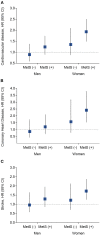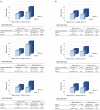Modification effect of changes in cardiometabolic traits in association between kidney stones and cardiovascular events
- PMID: 35958421
- PMCID: PMC9360502
- DOI: 10.3389/fcvm.2022.923981
Modification effect of changes in cardiometabolic traits in association between kidney stones and cardiovascular events
Abstract
Backgrounds: Whether longitudinal changes in metabolic status influence the effect of kidney stones on cardiovascular disease (CVD) remains unclarified. We investigated the modification effect of status changes in metabolic syndrome (MetS) in the association of kidney stones with risk of incident CVD events.
Methods: We performed a prospective association and interaction study in a nationwide cohort including 129,172 participants aged ≥ 40 years without CVDs at baseline and followed up for an average of 3.8 years. Kidney stones information was collected by using a questionnaire and validated by medical records. The repeated biochemical measurements were performed to ascertain the metabolic status at both baseline and follow-up.
Results: 4,017 incident total CVDs, 1,413 coronary heart diseases (CHDs) and 2,682 strokes were documented and ascertained during follow-up. Kidney stones presence was significantly associated with 44%, 70% and 31% higher risk of CVDs, CHDs and stroke, respectively. The stratified analysis showed significant associations were found in the incident and sustained MetS patients, while no significant associations were found in the non-MetS at both baseline and follow-up subjects or the MetS remission ones, especially in women. For the change status of each single component of the MetS, though the trends were not always the same, the associations with CVD were consistently significant in those with sustained metabolic disorders, except for the sustained high blood glucose group, while the associations were consistently significant in those with incident metabolic disorders except for the incident blood pressure group. We also found a significant association of kidney stone and CVD or CHD risk in the remain normal glucose or triglycerides groups; while the associations were consistently significant in those with incident metabolic disorders except for the incident blood pressure group. We also found a significant association of kidney stone and CVD or CHD risk in the remain normal glucose or triglycerides groups.
Conclusions: A history of kidney stones in women with newly developed MetS or long-standing MetS associated with increased risk of CVD. The mechanisms link kidney stones and CVD risk in the metabolic and non-metabolic pathways were warranted for further studies.
Keywords: CVD; kidney stone; longitudinal change; metabolic disorders; modification effect.
Copyright © 2022 Xu, Zhao, Shen, Hu, Lu, Xu, Wang, Li, Chen, Chen, Chen, Chen, Deng, Gao, Huo, Li, Liu, Luo, Mu, Qin, Qin, Shi, Su, Wan, Wang, Wang, Wang, Wu, Xu, Yan, Yang, Ye, Yu, Zhang, Zhao, Zeng, Wang, Bi, Tang and Ning.
Conflict of interest statement
The authors declare that the research was conducted in the absence of any commercial or financial relationships that could be construed as a potential conflict of interest.
Figures


References
LinkOut - more resources
Full Text Sources

